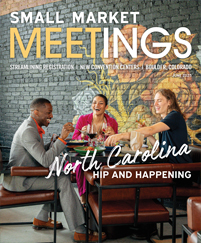River cruises, murder mystery dinners at historic mansions and wildlife encounters — the potential for off-site events is nearly limitless.
Locations outside the conference center or hotel add an element of creativity to a business or sales meeting, introduce the perfect opportunity for networking and fun at a conference, and reward attendees on incentive trips. They can also incorporate elements of local culture and satisfy a business traveler’s longing for leisure travel.
With so many options to choose from, selecting a venue that will give attendees a unique and rewarding experience is critical. Check out these tips from experts to select the perfect off-site venue.
Expectations for Off-site Events
Discussing the client’s wants and needs, the look and feel of the event, and the pros and cons of each venue type is an important step in picking a venue. So is setting appropriate expectations.
“Usually I’ll have the conversation with the client to get a feel for what exactly they think they’re looking for and what they’re actually looking for,” said Rami Coppock, senior event planner at J.Shay Event Solutions. “We all have a tendency of having champagne dreams.”
It’s important to assess the goals of the off-site meeting. Is it a sales meeting, where there’s a lot of business to get done, or is it a networking opportunity? If it falls more on the business side of the spectrum, planners can make sure they’re looking exclusively for venues that include designated meeting space. Rooms with inspiring mountain views can bring the excitement of an off-site venue to a typical meeting.
If it falls more on the social or rewarding side of the spectrum, a different approach is warranted.
“If you want to make it special and this is a treat or reward or celebration and you’re looking at a destination to add to all this, what can you be doing?” said Aneta Key, founder of Aedea Partners, an events facilitation and consultation company in California.
It’s also important to consider what kind of event the off-site event is part of. If it’s taking up one evening of a multi-day conference, the site should be designed to give attendees a social and fun evening after a day of presentations and lectures. That means bringing the “wow factor” is important, and that’s where interesting venues with fun activities come in.
Trips to vineyards, happy hours with unique wildlife or even fun outdoor venues like a white-water rafting park are excellent options that entertain attendees and make lasting memories.
Creatively Sourcing Venues
Once they’ve determined the energy they want to bring into their event and the goals of the event, planners should choose a venue. With so many options, it can be overwhelming to find a venue that represents a destination’s personality without being too cliché or uninspired.
“Business travelers are looking to their travel as a chance to do some leisure travel as well, so bring in that local culture and destination,” said Leanne Calderwood, vice president of global accounts at Conference Direct.
Off-site events are a great way to tie in local culture and create a theme. Sometimes that theme is obvious; a trip to Indianapolis warrants an Indy 500 event, such as a reception at the Indianapolis Motor Speedway. An off-site event held in Kentucky is a great opportunity to tie in bourbon and horses with a tour of a racetrack or a distillery.
“I’m based in San Francisco, and here, the usual suspect is wine country,” Key said.
Planners can also tie in broader themes across the event planning industry or base their events off cultural trends for an added element of creativity and memorability. With period dramas like Netflix’s “Bridgerton” trending globally, a ball held at a historic home might be one of the most memorable events for attendees.
“Take advantage of the hotspots and hip areas and what’s trending,” Coppock said. “Speakeasys have been hot for the last five years.”
Calderwood said the types of venues that appeal to her are “ones that are repurposing spaces into something different, like taking a warehouse or airline hangar and transforming it into something different. That’s a great way to highlight those hidden gem venues to create an experience.”
When it comes to sourcing these venues, planners have several options. One method is as simple as pulling up a map of the area and researching nearby attractions. This can work if the planner knows the area very well, but other tools and research methods can save them time.
“One is a site-sourcing tool called Cvent, which has good listings and accurate information on off-site venues,” Calderwood said. “Another source I use is the DMO in that location and asking them for their recommendations.”
CVBs and DMOs make valuable allies when choosing an off-site venue because representatives have firsthand knowledge of a place’s hidden gems, business closures or remodels, and favorite activities among locals.
Another way planners can source their events is through their clients. Some clients may have existing ties to a venue that make it an obvious choice. This is especially true in the years after the pandemic, when many events were cancelled or postponed.
“Often they have preexisting relationships, so they may have a master account with a given venue, or maybe they have credit based on prior events,” Key said.
Looking at Logistics
Sometimes it’s tempting to gloss over the off-site event because of all the additional logistics they entail. Added costs, transportation and rental requirements are all things planners must consider when selecting a venue.
Ultimately, budget is going to be the determining factor. Planners should look for venues that offer multiple price points or are willing to negotiate.
Transportation is another potentially difficult piece of the planning puzzle. Is it something attendees can grab an Uber or walk to, or should the client charter a shuttle to take them to and from the venue?
“I think there’s a lot of value in having a local event planner or DMC to help you with logistics of transportation,” said Calderwood.
Coppock said another factor she considers is the safety of the transportation. If the off-site venue is within walking distance of the hotel, look at the security of the area and whether the sun will be up or down. If it’s not in the most well-lit or secure location, or it’s not very walkable, arranging group transportation to the off-site is imperative.
Catering can pose a question, too. Sometimes distinct venues, like converted warehouses or airline hangars, may not have a full catering kitchen or a liquor license. If the client only wants light appetizers, that may be something a planner can work around by hiring an external caterer. Some venues might have exclusive catering and vendor lists, which may increase the price.
Key said selecting a venue with audiovisual capabilities saves time but that some less traditional venues may be lacking in the technology department.
“It’s very clear which venues have figured out the art of the hybrid meeting and which are struggling,” Key said.
Another logistical consideration for off-site venues is the expected attendance. If the event is part of something larger, like a conference or trade show, attendance could be optional, and there may be some no-shows. If that’s the case, planners may want to consider picking a venue that’s close so they’re not wasting money on transportation for attendees who won’t show up. The same is true with food and beverage — if a planner suspects some attendees will opt out of the off-site event, they can choose a buffet or appetizers as opposed to a plated dinner so resources aren’t wasted.












